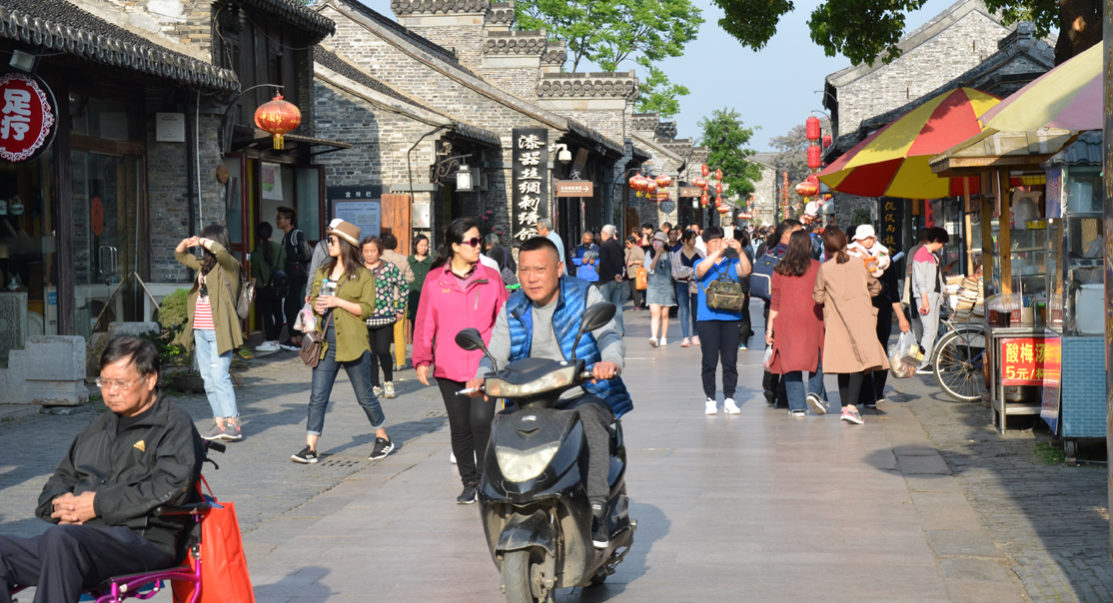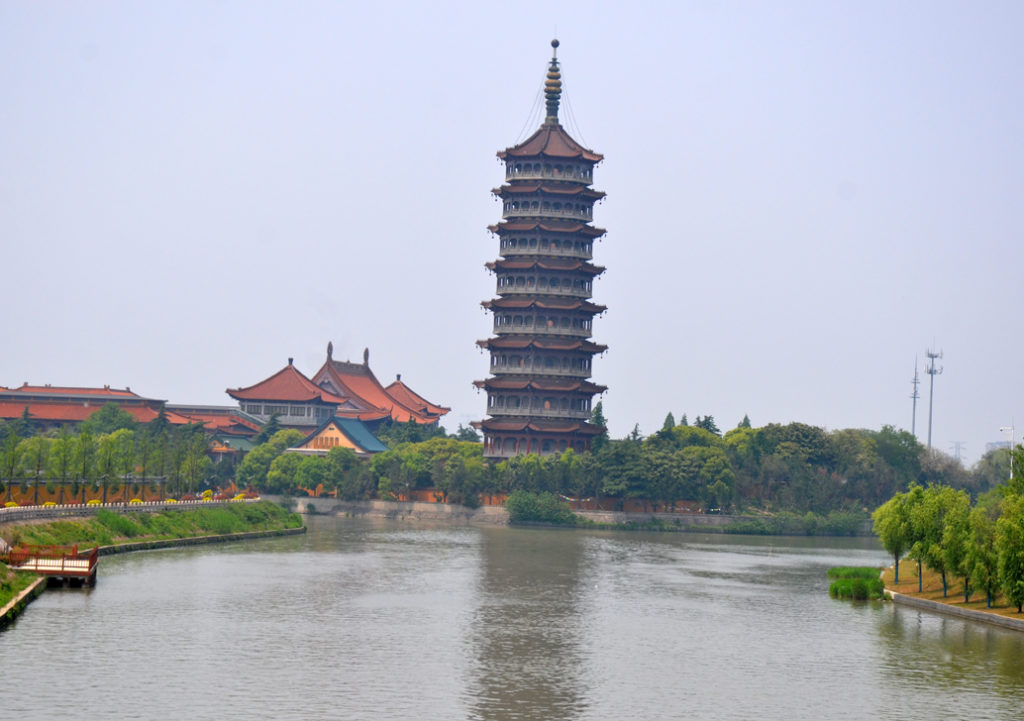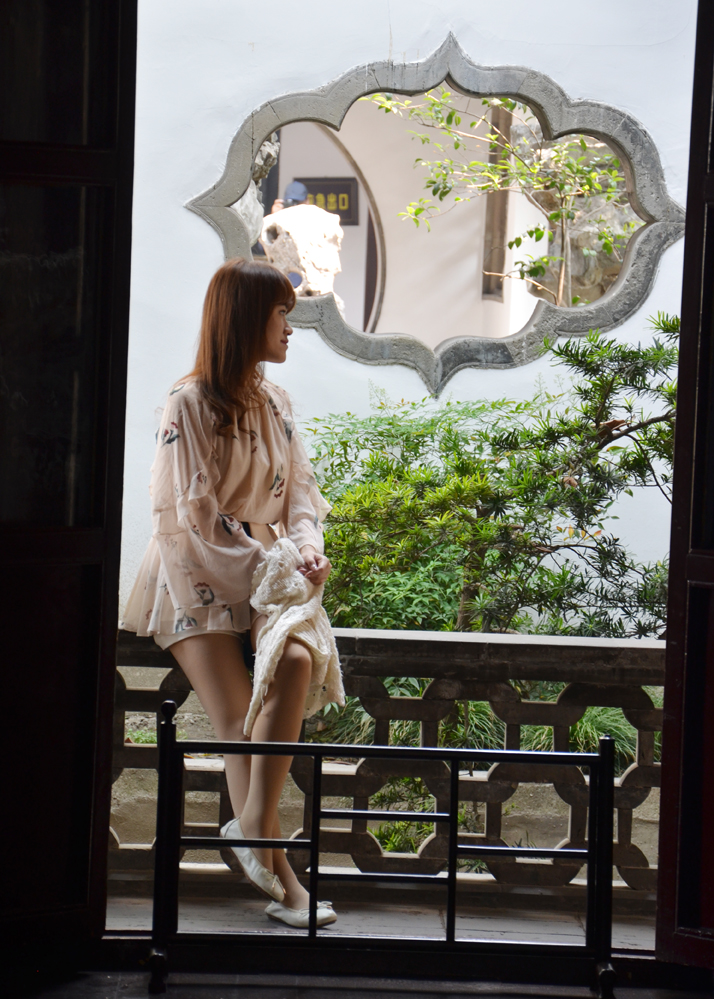By David DeVoss
Since the days of Marco Polo, the West has been fascinated with China. At a time when feudal lords governed Europe, China enjoyed a bureaucracy staffed with Mandarins selected by rigorous examination. In the 6th Century, when rats from Egypt overran Constantinople and started a plague that would ravage most of the known Western world, Siu Dynasty emperors were building a Grand Canal that would carry grain 1,800 km from fertile lands south of the Yangtze River to more arid provinces around Beijing.
As centuries rolled past, wondrous tales of an exotic Middle Kingdom were carried west across the Steppes by traders on the Silk Road and beyond the Indian Ocean to the Arabian Peninsula by Chinese admirals in charge of Ming Dynasty treasure fleets. By the 17th Century, romantic poets like Samuel Taylor Coleridge were writing imaginary depictions of China based on fanciful travelers’ tales.
In Xanadu did Kubla Khan
A stately pleasure-dome decree:
Where Alph, the sacred river, ran
Through caverns down to a sunless sea.
For Americans anxious to experience the world’s most rapidly developing country, the main question to ask is not when to go but where. Having explored the former British and Portuguese colonies of Hong Kong and Macau, most travelers begin in Beijing, the ancient Imperial capital, or in Shanghai, the global commercial center on the East China Sea. Beijing is close to the Great Wall, the Ming Tombs and offers Tiananmen Square from where foreigners can explore the Forbidden City. Shanghai is where East meets West. It has hotels with rooms literally hovering above the clouds not far from old colonial neighborhoods that look much as they did a century ago when the city was divided into foreign concessions.
But where do you go next? One possibility is Xian where 8,000 terracotta soldiers have guarded the tomb of Chinese Emperor Qin Shi Huang for the past 2,300 years. Or Guangzhou, the great Cantonese entrepôt on the Pearl River, where British colonial warehouses once filled with opium now house elegant art galleries and high fashion boutiques.
But travelers wishing to truly understand China’s rich history must venture beyond the opulent gateways into the real China, a land shaped by wealth and war, to the city of Yangzhou. Located just north of the Yangtze River in Jiangsu Province, Yangzhou offers modern comfort, exotic beauty, distinctive cuisine and historic sites that reflect the grandeur of the past and the promise of the present.
Yangzhou is a city of 6,000,000 that sits in the middle of China’s richest province. The city is famous for feminine beauty, imaginative gardens and artistic handicrafts that include lacquer and stoneware, bamboo carving, cutlery and block printing. Knives and cleavers made in the city are so finely honed that cooks can slice a 1-cm-thick bean curd into 30 paper-thin shreds without breaking a single one. The curds then are stewed for hours with chopped bamboo shoots and tiny shrimp in a chicken broth to create a clear yet savory umami-flavored soup called dazhu gansi.
Many Chinese think Yangzhou cuisine is the country’s most sophisticated, For the western palate, however, it easiest way to describe the taste is to explain what it is not. Yangzhou food is less bland than Cantonese, less spicy than Sichuanese and lighter than the fare served in Beijing and Hebei. In addition to dazhu gansi, Yangzhou restaurants also offer cold bean curd cut into long slender strips, dressed with sesame oil and garnished with cucumber and chili. Other specialties include a large ground pork meatball called “lion’s head” served in a tureen of soup and “drunken prawns” which consist of fresh shrimp placed in a bowl of Chinese wine, where they flop about wildly as they ingest the alcohol.
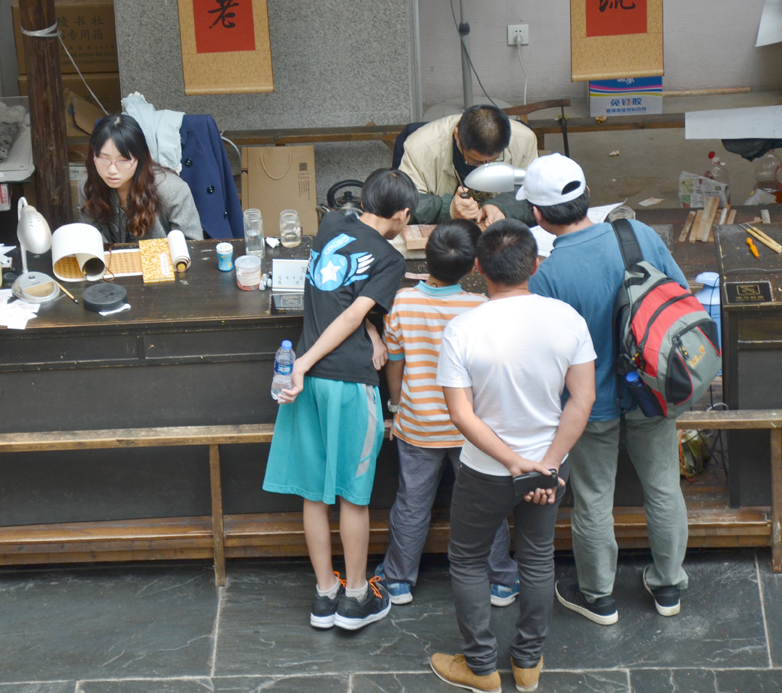
Craftsmen making traditional wood block prints at the Yangzhou Museum are popular with children fascinated by the intricate carving. Photo by David DeVoss
Yangzhou’s history extends back 2,400 years, but the city did not really come into its own until the 7th century when Yang Di, the second emperor of the Sui Dynasty started building the Grand Canal. The Sui already had unified the country militarily; the Grand Canal would bind the country together economically. Constructed in less than a decade, the canal allowed emperors to feed soldiers guarding the Great Wall with grain from the south and to move troops rapidly around the country when the need arose. It also allowed Yang Di and his wife to travel easily to Yangzhou, the city they considered home.
A 7th Century journal describes an imperial journey from Luoyang down to Yangzhou. Boatmen hired from all the waterways pulled the vessels by ropes of green silk. The emperor rode in a dragon boat. The boats followed one another poop to prow for more than 200 leagues (some 65 miles).” In 616 A.D., when opposition to his rule turned violent, Yang Di sailed south on the canal to Yangzhou where he took refuge until the Sui Dynasty ended with his death in 618 A.D.
Most of the 10,000 Americans who visit Yangzhou annually are surprised that the canal, now a UNESCO World Heritage site, has changed so little over the centuries. Unlike the Erie Canal in Buffalo, the canal running through Yangzhou does not anchor a strip of boisterous bars and cafes. It runs serenely beside temples and pagodas before becoming the eastern edge of Yangzhou’s downtown.
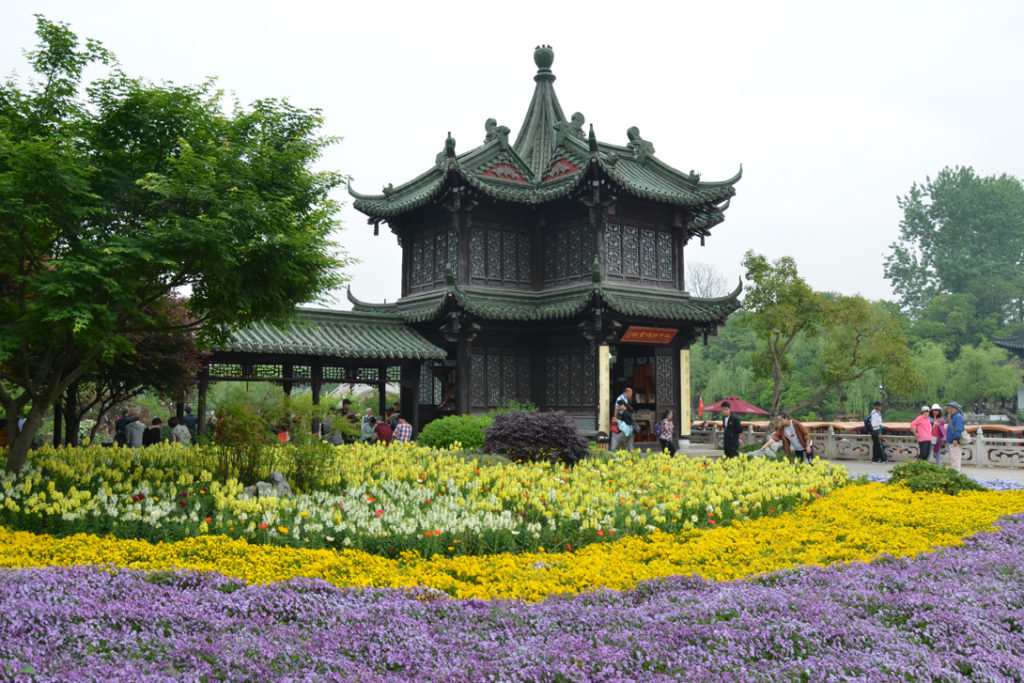
Built by a wealthy merchant, the Xixhun Mansion once hosted a birthday party for Qing Emperor Qianlong. Photo by David DeVoss
By the middle of the Tang Dynasty in the 8th century, Yangzhou had become a hub for water transportation in China with a population of 500,000 that attracted merchants from Syria, Arabia and the Iberian Peninsula. By the start of the Song Dynasty 200 years later Yangzhou was the richest city in China, a booming metropolis whose GDP equaled 1% of that of the entire world.
The main source of the city’s wealth was salt. About 5,000 to 6,000 years ago, the Yangtze River emptied into the sea at Yangzhou. Over the millennia, silt carried down the Yangtze from Tibet gradually pushed the shoreline 194 miles eastward to where Shanghai is located today. Yangzhou’s former proximity to the ocean left it with geology where brine wells and salt formations can be found.
Today, salt is a dinner table condiment and ubiquitous mineral spread on icy streets. But in China salt was one of the drivers of early civilization. Salt crystals produced by boiling briny water in iron pots allowed Chinese to make soy sauce and pickled vegetables that made a rice diet more palatable. Chinese also discovered that mixing potassium nitrate, a salt otherwise known as saltpeter, with sulfur and carbon created a powder that when ignited produced an explosion. By the time Marco Polo arrived in China in 1274 salt was a highly regulated and taxed commodity that produced tremendous government revenue. Yangzhou nineteenth century salt merchants who paid high fees and taxes for the privilege of being monopoly traders flaunted their wealth and, like the Medici of Florence, built mansions, gardens and supported local artists.
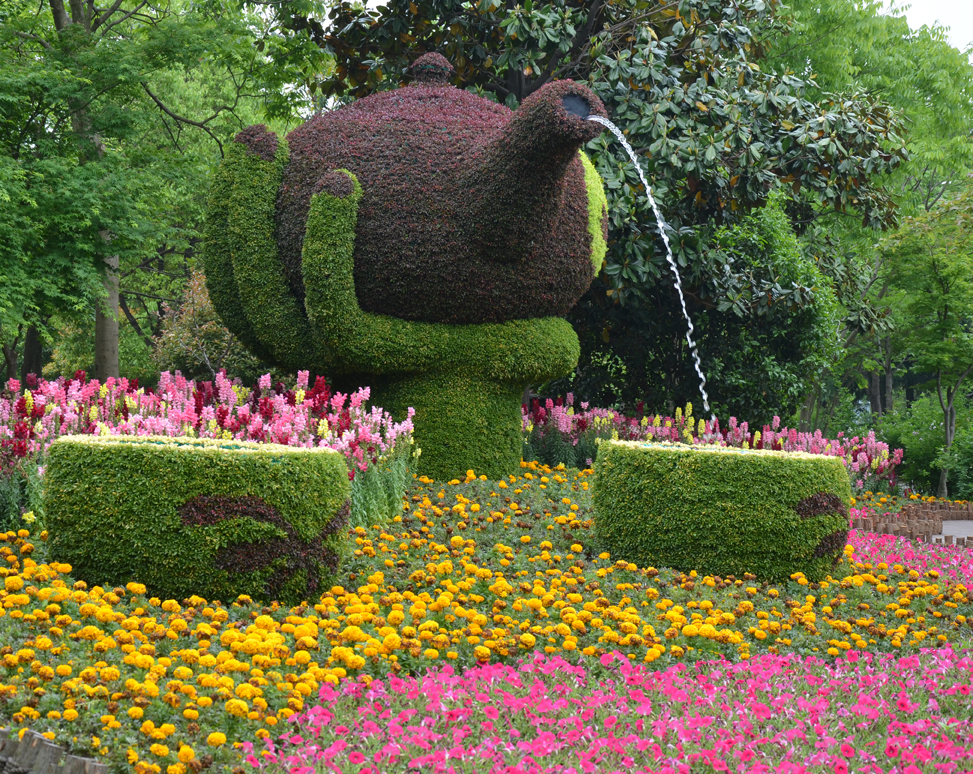
A temperate climate and skilled gardeners produce floral artistry at Yangzhou’s Slender West Lake. Photo by David DeVoss
Because of their imperial connections and enormous wealth, salt merchants were expected to be problem solvers when a solution required money. During one of his many visits to Yangzhou, Qianlong, the sixth emperor if the Manchu-led Qing Dynasty, asked if the city had a white tower-like pavilion similar to the dagoba existing in Beijing. Not wanting to appear provincial, city officials falsely claimed that they did. They immediately regretted their boasting when Qianlong asked to see the pavilion the following morning when he went boating on Slender Lake.
Lying to the Emperor was no minor offense. The officials could become eunuchs if they failed to produce a white pavilion. Fortunately, a wealthy salt merchant stepped forward and promised a white pavilion by the following morning. The merchant’s offer was motivated by more than civic pride. In order to keep their exclusive possession of the salt trade merchants, apart from tax payments and donations, spared no effort to curry favor with royal power which entailed greeting the emperor’s “honor of arrival” in Yangzhou.
Laboring all night, his workers produced a structure out of salt blocks that was sturdy enough to support a tile roof. When he saw the white pavilion the next day the Emperor was pleased and Yangzhou’s reputation remained in tact – along with the appendages of its officials.
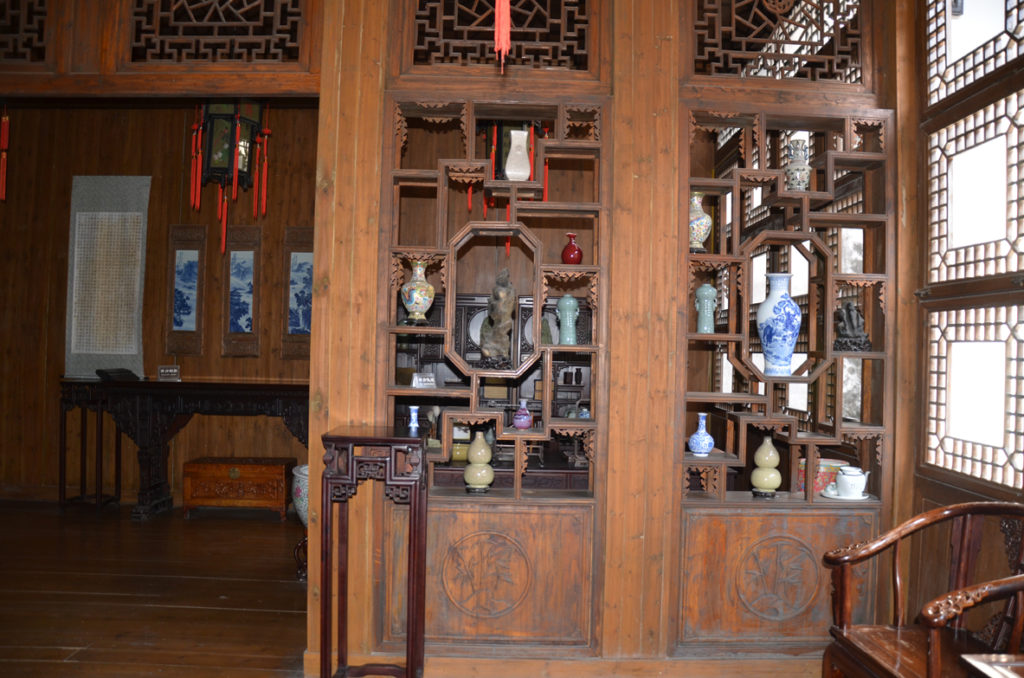
Yangzhou’s Geyuan Garden is built around a sprawling mansion built by salt “satrap” Huang Zhiyun during the Qing Dynasty. Photo by David DeVoss
The history of salt in Yangzhou lives on in the beauty of the Ge and Ho Gardens (see Yangzhou’s Gardens of Delight) and the 1897 residence of salt merchant Lu, a nine-story mansion that has numerous banquet rooms decorated with illuminated red lanterns. The residence actually is an enormous compound with lighted ally ways, large courtyards and high-ceilinged dining halls where food is prepared by your own private chef.
The Qing Dynasty (1644 – 1911) was Yangzhou’s second golden age. If you’d like to sample the life of a rich merchant in the 19th Century consider staying at the Yangzhou Center & Residence close to the middle of town. The hotel has 139 rooms, many of which overlook a tranquil garden with burbling watercourses, elaborate rockeries, pathways lined with calligraphy and a Qing Dynasty pavilion perfect for evening libations.
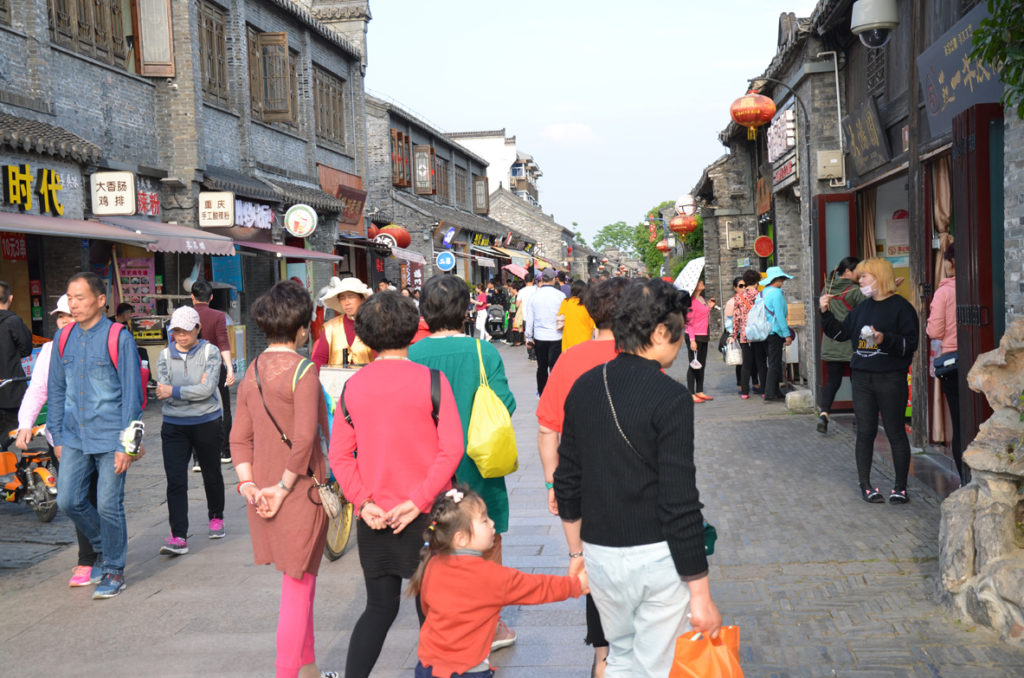
Crowded with shoppers, foodies and the simply curious, Dong Guan St. dates from the Qing Dynasty. Photo by David DeVoss
Just beyond the hotel entrance is Dongguan Street, a Qing Dynasty shopping area that is lined with craft shops, antique stores, snack vendors, boutiques and candy makers producing peanut brittle and honeycomb delicacies. Running 1,120 meters down to the old city moon gate, Dongguan is worth several explorations since the street’s atmosphere tends to change with the hour of the day. Motorcycles annoyingly thread their way between pedestrians, but, since no cars are allowed, residents who live in houses off narrow ally ways behind the shops need some way to get home.
The souvenirs here are surprisingly well made and authentic to South China’s culture. Women’s hats are a great buy as are the cleavers and cutlery. Dongguan is one of the top ten historic and cultural streets in China and you’ll find people very well behaved. But beware the selfie sticks!
There are about 200 private gardens in Yangzhou and one of the nicest is midway down Dongguan at No. 167. It belongs to Du Xiang Kai, a local artist famous for his block printing, who will invite you in for a quick look if you arrive with an interpreter. Du is proud of his flowers, fishpond and convivial pavilion and what they represent. “Most of my guests come from other cities in China,” he admits. “Hong Kong and Taiwan Chinese have lost the art of tea and conversation.”
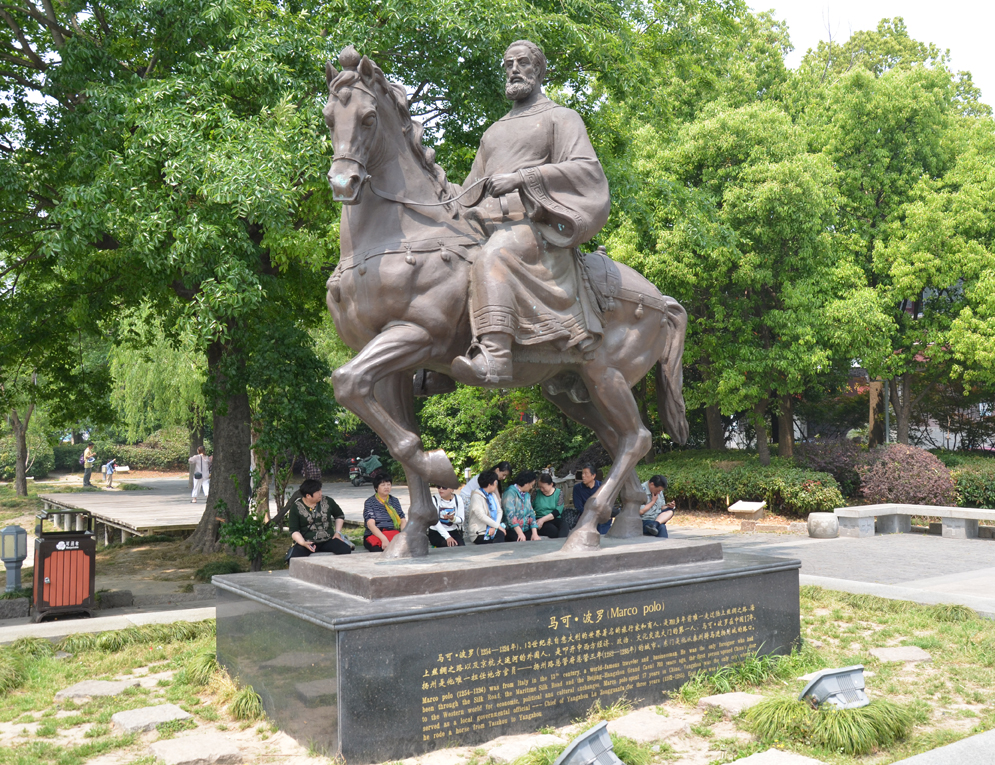
Marco Polo remains Yangzhou’s most famous resident. His museum is next to the East Gate leading to Dong Huan St. Photo by David DeVoss
At the far end of Dongguan St. just beyond the city wall you’ll find the Marco Polo Memorial Hall. It’s well worth a visit if only because Marco Polo served as mayor of Yangzhou from 1282 to 1285.
In the Travels of Marco Polo, dictated to a fellow prisoner with whom he shared a cell in Genoa following a failed attack by the city-state of Venice, Polo says Yangzhou “must be considered a place of great consequence. It belongs to the dominion of the great Khan. The people subsist by trade and martial arts. They manufacture arms and all sorts of warlike accouterments; in consequence of which many troops are stationed in this part of the country.”
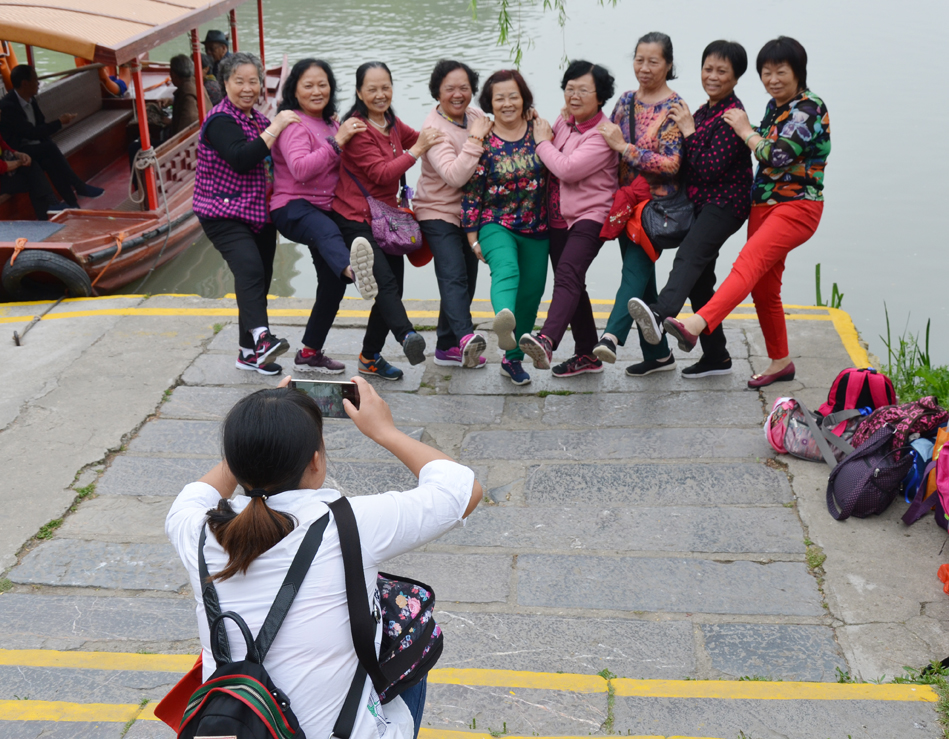
Thousands of visitors from throughout China travel to Yangzhou to see historical sites developed during past dynasties. Photo by David DeVoss
For three centuries following Marco Polo’s departure from China, Yangzhou managed to avoid military conflict. But in May 1645 the city’s strategic location at the confluence of the Grand Canal and Yangtze River, and its loyalty to the Ming Dynasty, made it a target of the Qing Dynasty’s Manchurian army. The Ming’s southern army commander told his troops to hold Yangzhou at any cost. He could not have known that when the Manchu took the city they would slaughter over the course of ten days all the Ming defenders and 800,000 ordinary citizens.
The mass executions left one of China’s most prosperous cities with only several thousand residents. To this day the Yangzhou massacre remains the largest in recorded human history.
There are no physical reminders of Yangzhou’s darkest day. Save for the city’s Qing gardens, salt merchant mansions, ancient pagodas, memorial parks and Buddhist temples, Yangzhou seems thoroughly modern. The city’s main boulevard, Wenchang Road, is lined with shade trees, has landscaped traffic medians and is free of the rush hour traffic. Mindful of its heritage – Yangzhou is the setting for four of China’s great classic novels – building heights are restricted around the historic part of the city close to the Grand Canal.
An efficient way to begin your exploration of Yangzhou is with a two-hour visit to the Yangzhou Museum, which also features a permanent exhibition of Chinese block printing. It presents the region’s 2,400 years of history in compelling fashion with English language signage.
You’ll require more time to appreciate Daming Temple, a 1,500-year old temple complex
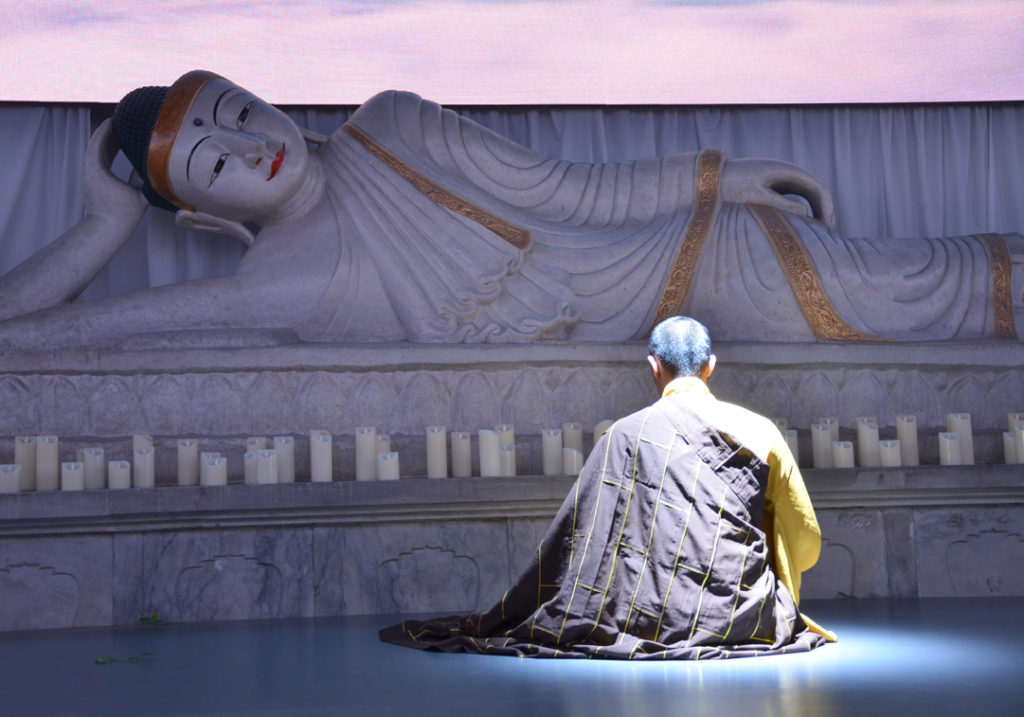
The Daming Temple show highlights the life and labors of Tang Dynasty monk Jianzhen. Photo by David DeVoss
A quick walk from Slender West Lake, the temple integrates Buddhism, cultural and historical relics and garden landscapes with the towering Qiling pagoda. Unlike some of China’s newer “Buddhist temples,” which were conceived as tourist attractions and have little religious significance, Daming Temple has a strong and storied history. It is most famous for the Yangzhou monk Jianzhen who studied the sutras and initiated people into monkhood in 742 A.D. before leaving to spread the Buddhist faith and Chinese medicine and culture in Japan.
An interpretive theatrical presentation in which acrobatic dancers tell the story of Jianzhen’s efforts to unite China and Japan through the shared faith of Buddhism occurs most days inside the temple’s Jianzhen Memorial Hall.
The life of this Tang Dynasty monk resonates to this day. During World War II China implored its American ally not to bomb Kyoto or Nara in Japan because of Jianzhen’s missionary work there. Neither city was touched.
During China’s Cultural Revolution from 1966 to 1976, Red Guard extremists attempted to destroy Daming Temple but were prevented from doing so by Chinese Premier Zhou Enlai, who forcefully argued that harming the temple would provoke an international incident with Japan.![]()
_____________
East-West News Service editor David DeVoss has made more than a dozen trips to China.


